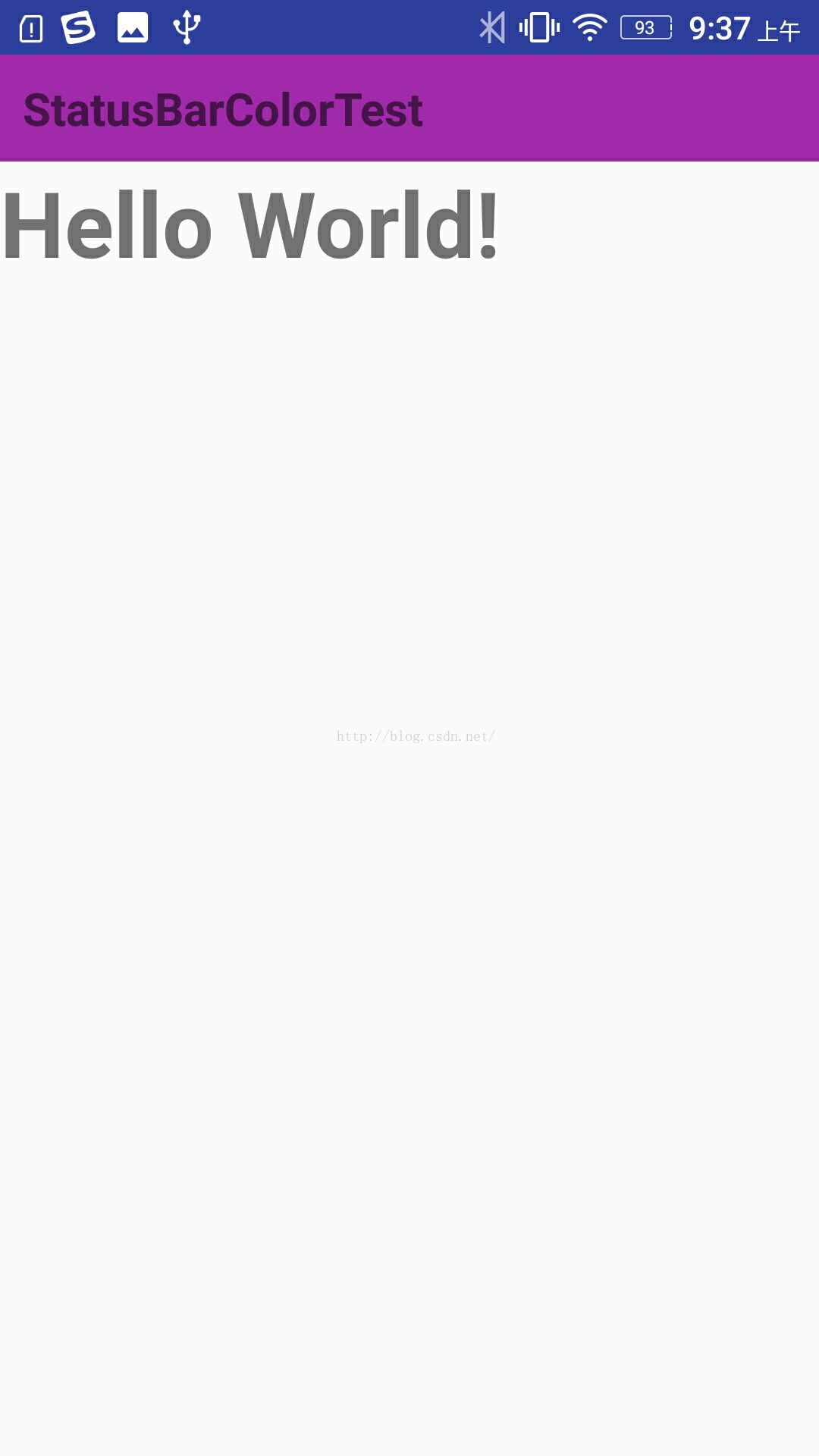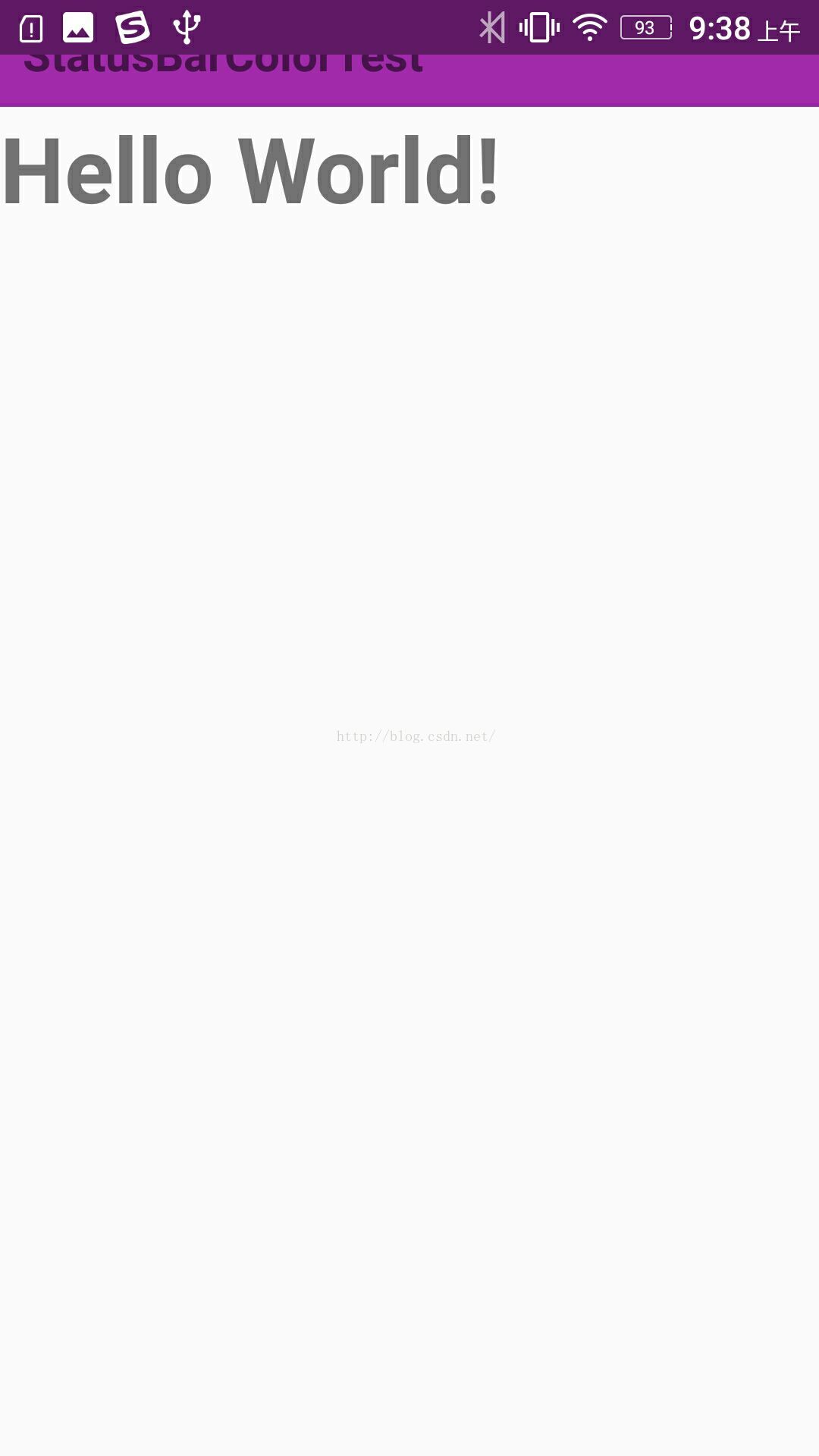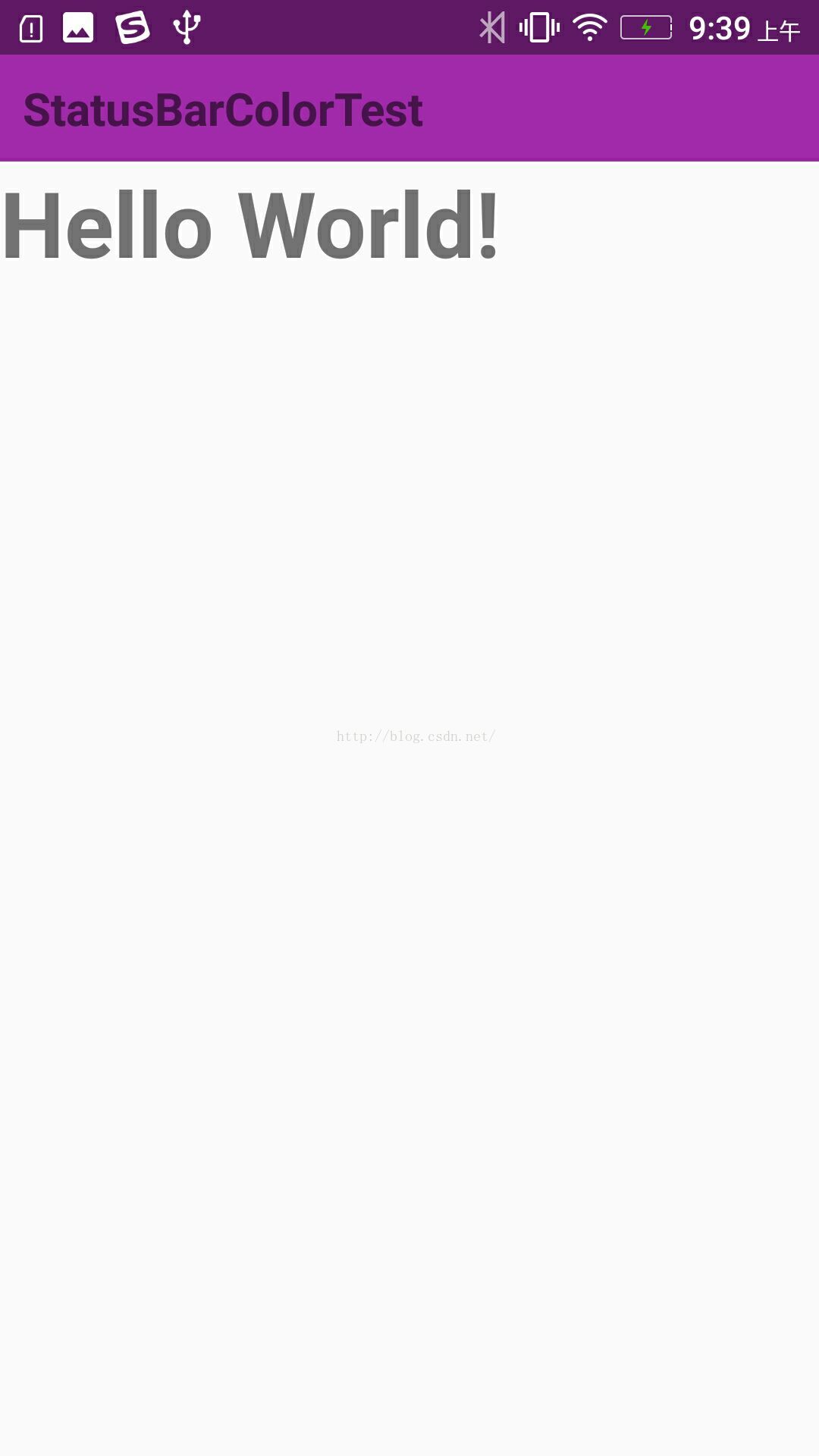每次看IOS上的应用,应用中状态栏的颜色总能与应用标题栏颜色保持一致,用户体验很不错,对于这种效果,像我这种好奇心强的人就会去看看那安卓是否可以呢?若是在安卓4.4之前,答案是否定的,但在4.4之后,谷歌允许开发者自定义状态栏背景颜色啦,这是个不错的体验!若你手机上安装有最新版的qq,并且你的安卓SDK版本是4.4及以上,你可以看下它的效果:

实现此功能有两种方法:
1.在xml中设置主题或自定义style;
Theme.Holo.Light.NoActionBar.TranslucentDecor
Theme.Holo.NoActionBar.TranslucentDecor
|
1
2
3
4
5
6
|
<style name=
"AppTheme"
parent=
"AppBaseTheme"
>
<!-- Status Bar -->
<item name=
"android:windowTranslucentStatus"
>
true
</item>
<!-- Navigation Bar -->
<item name=
"android:windowTranslucentNavigation"
>
true
</item>
</style>
|
鉴于市面上各种手机的SDK的各种版本,不建议采用这种方法;
2.在代码中控制;
首先创建一个Activity,在onCreate方法中进行处理:
|
1
2
3
4
5
6
7
8
9
10
11
12
13
14
15
16
17
18
19
20
21
22
23
|
@Override
protected
void
onCreate(Bundle savedInstanceState) {
super
.onCreate(savedInstanceState);
if
(Build.VERSION.SDK_INT >= Build.VERSION_CODES.KITKAT) {
setTranslucentStatus(
true
);
SystemBarTintManager tintManager =
new
SystemBarTintManager(
this
);
tintManager.setStatusBarTintEnabled(
true
);
tintManager.setStatusBarTintResource(R.color.barcolor);
//通知栏所需颜色
}
setContentView(R.layout.activity_main);
}
@TargetApi
(
19
)
private
void
setTranslucentStatus(
boolean
on) {
Window win = getWindow();
WindowManager.LayoutParams winParams = win.getAttributes();
final
int
bits = WindowManager.LayoutParams.FLAG_TRANSLUCENT_STATUS;
if
(on) {
winParams.flags |= bits;
}
else
{
winParams.flags &= ~bits;
}
win.setAttributes(winParams);
}
|
需注意的是, tintManager.setStatusBarTintResource(R.color.top_bg_color);这一步的颜色值(即把你的状态栏颜色与你的标题栏颜色保持一致)要写在color.xml中去,如果用Color.praseColor则会报错。
SystemBarTintManager.java文件
|
1
2
3
4
5
6
7
8
9
10
11
12
13
14
15
16
17
18
19
20
21
22
23
24
25
26
27
28
29
30
31
32
33
34
35
36
37
38
39
40
41
42
43
44
45
46
47
48
49
50
51
52
53
54
55
56
57
58
59
60
61
62
63
64
65
66
67
68
69
70
71
72
73
74
75
76
77
78
79
80
81
82
83
84
85
86
87
88
89
90
91
92
93
94
95
96
97
98
99
100
101
102
103
104
105
106
107
108
109
110
111
112
113
114
115
116
117
118
119
120
121
122
123
124
125
126
127
128
129
130
131
132
133
134
135
136
137
138
139
140
141
142
143
144
145
146
147
148
149
150
151
152
153
154
155
156
157
158
159
160
161
162
163
164
165
166
167
168
169
170
171
172
173
174
175
176
177
178
179
180
181
182
183
184
185
186
187
188
189
190
191
192
193
194
195
196
197
198
199
200
201
202
203
204
205
206
207
208
209
210
211
212
213
214
215
216
217
218
219
220
221
222
223
224
225
226
227
228
229
230
231
232
233
234
235
236
237
238
239
240
241
242
243
244
245
246
247
248
249
250
251
252
253
254
255
256
257
258
259
260
261
262
263
264
265
266
267
268
269
270
271
272
273
274
275
276
277
278
279
280
281
282
283
284
285
286
287
288
289
290
291
292
293
294
295
296
297
298
299
300
301
302
303
304
305
306
307
308
309
310
311
312
313
314
315
316
317
318
319
320
321
322
323
324
325
326
327
328
329
330
331
332
333
334
335
336
337
338
339
340
341
342
343
344
345
346
347
348
349
350
351
352
353
354
355
356
357
358
359
360
361
362
363
364
365
366
367
368
369
370
371
372
373
374
375
376
377
378
379
380
381
382
383
384
385
386
387
388
389
390
391
392
393
394
395
396
397
398
399
400
401
402
403
404
405
406
407
408
409
410
411
412
413
414
415
416
417
418
419
420
421
422
423
424
425
426
427
428
429
430
431
432
433
434
435
436
437
438
439
440
441
442
443
444
445
446
447
448
449
450
451
452
453
454
455
456
457
458
459
460
461
462
463
464
465
466
467
468
469
470
471
472
473
474
475
476
477
478
479
480
481
482
483
484
485
486
487
488
489
490
491
492
493
494
495
496
|
package
com.test.statusbarcolor;
import
android.annotation.SuppressLint;
import
android.annotation.TargetApi;
import
android.app.Activity;
import
android.content.Context;
import
android.content.res.Configuration;
import
android.content.res.Resources;
import
android.content.res.TypedArray;
import
android.graphics.drawable.Drawable;
import
android.os.Build;
import
android.util.DisplayMetrics;
import
android.util.TypedValue;
import
android.view.Gravity;
import
android.view.View;
import
android.view.ViewConfiguration;
import
android.view.ViewGroup;
import
android.view.Window;
import
android.view.WindowManager;
import
android.widget.FrameLayout.LayoutParams;
import
java.lang.reflect.Method;
/**
* Created by lplj on 2016/9/6.
* Class to manage status and navigation bar tint effects when using KitKat
* translucent system UI modes.
*
*/
@SuppressWarnings
({
"rawtypes"
,
"unchecked"
})
public
class
SystemBarTintManager {
static
{
// Android allows a system property to override the presence of the navigation bar.
// Used by the emulator.
if
(Build.VERSION.SDK_INT >= Build.VERSION_CODES.KITKAT) {
try
{
Class c = Class.forName(
"android.os.SystemProperties"
);
Method m = c.getDeclaredMethod(
"get"
, String.
class
);
m.setAccessible(
true
);
sNavBarOverride = (String) m.invoke(
null
,
"qemu.hw.mainkeys"
);
}
catch
(Throwable e) {
sNavBarOverride =
null
;
}
}
}
/**
* The default system bar tint color value.
*/
public
static
final
int
DEFAULT_TINT_COLOR =
0x99000000
;
private
static
String sNavBarOverride;
private
final
SystemBarConfig mConfig;
private
boolean
mStatusBarAvailable;
private
boolean
mNavBarAvailable;
private
boolean
mStatusBarTintEnabled;
private
boolean
mNavBarTintEnabled;
private
View mStatusBarTintView;
private
View mNavBarTintView;
/**
* Constructor. Call this in the host activity onCreate method after its
* content view has been set. You should always create new instances when
* the host activity is recreated.
*
* @param activity The host activity.
*/
@TargetApi
(
19
)
public
SystemBarTintManager(Activity activity) {
Window win = activity.getWindow();
ViewGroup decorViewGroup = (ViewGroup) win.getDecorView();
if
(Build.VERSION.SDK_INT >= Build.VERSION_CODES.KITKAT) {
// check theme attrs
int
[] attrs = {android.R.attr.windowTranslucentStatus,
android.R.attr.windowTranslucentNavigation};
TypedArray a = activity.obtainStyledAttributes(attrs);
try
{
mStatusBarAvailable = a.getBoolean(
0
,
false
);
mNavBarAvailable = a.getBoolean(
1
,
false
);
}
finally
{
a.recycle();
}
// check window flags
WindowManager.LayoutParams winParams = win.getAttributes();
int
bits = WindowManager.LayoutParams.FLAG_TRANSLUCENT_STATUS;
if
((winParams.flags & bits) !=
0
) {
mStatusBarAvailable =
true
;
}
bits = WindowManager.LayoutParams.FLAG_TRANSLUCENT_NAVIGATION;
if
((winParams.flags & bits) !=
0
) {
mNavBarAvailable =
true
;
}
}
mConfig =
new
SystemBarConfig(activity, mStatusBarAvailable, mNavBarAvailable);
// device might not have virtual navigation keys
if
(!mConfig.hasNavigtionBar()) {
mNavBarAvailable =
false
;
}
if
(mStatusBarAvailable) {
setupStatusBarView(activity, decorViewGroup);
}
if
(mNavBarAvailable) {
setupNavBarView(activity, decorViewGroup);
}
}
/**
* Enable tinting of the system status bar.
*
* If the platform is running Jelly Bean or earlier, or translucent system
* UI modes have not been enabled in either the theme or via window flags,
* then this method does nothing.
*
* @param enabled True to enable tinting, false to disable it (default).
*/
public
void
setStatusBarTintEnabled(
boolean
enabled) {
mStatusBarTintEnabled = enabled;
if
(mStatusBarAvailable) {
mStatusBarTintView.setVisibility(enabled ? View.VISIBLE : View.GONE);
}
}
/**
* Enable tinting of the system navigation bar.
*
* If the platform does not have soft navigation keys, is running Jelly Bean
* or earlier, or translucent system UI modes have not been enabled in either
* the theme or via window flags, then this method does nothing.
*
* @param enabled True to enable tinting, false to disable it (default).
*/
public
void
setNavigationBarTintEnabled(
boolean
enabled) {
mNavBarTintEnabled = enabled;
if
(mNavBarAvailable) {
mNavBarTintView.setVisibility(enabled ? View.VISIBLE : View.GONE);
}
}
/**
* Apply the specified color tint to all system UI bars.
*
* @param color The color of the background tint.
*/
public
void
setTintColor(
int
color) {
setStatusBarTintColor(color);
setNavigationBarTintColor(color);
}
/**
* Apply the specified drawable or color resource to all system UI bars.
*
* @param res The identifier of the resource.
*/
public
void
setTintResource(
int
res) {
setStatusBarTintResource(res);
setNavigationBarTintResource(res);
}
/**
* Apply the specified drawable to all system UI bars.
*
* @param drawable The drawable to use as the background, or null to remove it.
*/
public
void
setTintDrawable(Drawable drawable) {
setStatusBarTintDrawable(drawable);
setNavigationBarTintDrawable(drawable);
}
/**
* Apply the specified alpha to all system UI bars.
*
* @param alpha The alpha to use
*/
public
void
setTintAlpha(
float
alpha) {
setStatusBarAlpha(alpha);
setNavigationBarAlpha(alpha);
}
/**
* Apply the specified color tint to the system status bar.
*
* @param color The color of the background tint.
*/
public
void
setStatusBarTintColor(
int
color) {
if
(mStatusBarAvailable) {
mStatusBarTintView.setBackgroundColor(color);
}
}
/**
* Apply the specified drawable or color resource to the system status bar.
*
* @param res The identifier of the resource.
*/
public
void
setStatusBarTintResource(
int
res) {
if
(mStatusBarAvailable) {
mStatusBarTintView.setBackgroundResource(res);
}
}
/**
* Apply the specified drawable to the system status bar.
*
* @param drawable The drawable to use as the background, or null to remove it.
*/
@SuppressWarnings
(
"deprecation"
)
public
void
setStatusBarTintDrawable(Drawable drawable) {
if
(mStatusBarAvailable) {
mStatusBarTintView.setBackgroundDrawable(drawable);
}
}
/**
* Apply the specified alpha to the system status bar.
*
* @param alpha The alpha to use
*/
@TargetApi
(
11
)
public
void
setStatusBarAlpha(
float
alpha) {
if
(mStatusBarAvailable && Build.VERSION.SDK_INT >= Build.VERSION_CODES.HONEYCOMB) {
mStatusBarTintView.setAlpha(alpha);
}
}
/**
* Apply the specified color tint to the system navigation bar.
*
* @param color The color of the background tint.
*/
public
void
setNavigationBarTintColor(
int
color) {
if
(mNavBarAvailable) {
mNavBarTintView.setBackgroundColor(color);
}
}
/**
* Apply the specified drawable or color resource to the system navigation bar.
*
* @param res The identifier of the resource.
*/
public
void
setNavigationBarTintResource(
int
res) {
if
(mNavBarAvailable) {
mNavBarTintView.setBackgroundResource(res);
}
}
/**
* Apply the specified drawable to the system navigation bar.
*
* @param drawable The drawable to use as the background, or null to remove it.
*/
@SuppressWarnings
(
"deprecation"
)
public
void
setNavigationBarTintDrawable(Drawable drawable) {
if
(mNavBarAvailable) {
mNavBarTintView.setBackgroundDrawable(drawable);
}
}
/**
* Apply the specified alpha to the system navigation bar.
*
* @param alpha The alpha to use
*/
@TargetApi
(
11
)
public
void
setNavigationBarAlpha(
float
alpha) {
if
(mNavBarAvailable && Build.VERSION.SDK_INT >= Build.VERSION_CODES.HONEYCOMB) {
mNavBarTintView.setAlpha(alpha);
}
}
/**
* Get the system bar configuration.
*
* @return The system bar configuration for the current device configuration.
*/
public
SystemBarConfig getConfig() {
return
mConfig;
}
/**
* Is tinting enabled for the system status bar?
*
* @return True if enabled, False otherwise.
*/
public
boolean
isStatusBarTintEnabled() {
return
mStatusBarTintEnabled;
}
/**
* Is tinting enabled for the system navigation bar?
*
* @return True if enabled, False otherwise.
*/
public
boolean
isNavBarTintEnabled() {
return
mNavBarTintEnabled;
}
private
void
setupStatusBarView(Context context, ViewGroup decorViewGroup) {
mStatusBarTintView =
new
View(context);
LayoutParams params =
new
LayoutParams(LayoutParams.MATCH_PARENT, mConfig.getStatusBarHeight());
params.gravity = Gravity.TOP;
if
(mNavBarAvailable && !mConfig.isNavigationAtBottom()) {
params.rightMargin = mConfig.getNavigationBarWidth();
}
mStatusBarTintView.setLayoutParams(params);
mStatusBarTintView.setBackgroundColor(DEFAULT_TINT_COLOR);
mStatusBarTintView.setVisibility(View.GONE);
decorViewGroup.addView(mStatusBarTintView);
}
private
void
setupNavBarView(Context context, ViewGroup decorViewGroup) {
mNavBarTintView =
new
View(context);
LayoutParams params;
if
(mConfig.isNavigationAtBottom()) {
params =
new
LayoutParams(LayoutParams.MATCH_PARENT, mConfig.getNavigationBarHeight());
params.gravity = Gravity.BOTTOM;
}
else
{
params =
new
LayoutParams(mConfig.getNavigationBarWidth(), LayoutParams.MATCH_PARENT);
params.gravity = Gravity.RIGHT;
}
mNavBarTintView.setLayoutParams(params);
mNavBarTintView.setBackgroundColor(DEFAULT_TINT_COLOR);
mNavBarTintView.setVisibility(View.GONE);
decorViewGroup.addView(mNavBarTintView);
}
/**
* Class which describes system bar sizing and other characteristics for the current
* device configuration.
*
*/
public
static
class
SystemBarConfig {
private
static
final
String STATUS_BAR_HEIGHT_RES_NAME =
"status_bar_height"
;
private
static
final
String NAV_BAR_HEIGHT_RES_NAME =
"navigation_bar_height"
;
private
static
final
String NAV_BAR_HEIGHT_LANDSCAPE_RES_NAME =
"navigation_bar_height_landscape"
;
private
static
final
String NAV_BAR_WIDTH_RES_NAME =
"navigation_bar_width"
;
private
static
final
String SHOW_NAV_BAR_RES_NAME =
"config_showNavigationBar"
;
private
final
boolean
mTranslucentStatusBar;
private
final
boolean
mTranslucentNavBar;
private
final
int
mStatusBarHeight;
private
final
int
mActionBarHeight;
private
final
boolean
mHasNavigationBar;
private
final
int
mNavigationBarHeight;
private
final
int
mNavigationBarWidth;
private
final
boolean
mInPortrait;
private
final
float
mSmallestWidthDp;
private
SystemBarConfig(Activity activity,
boolean
translucentStatusBar,
boolean
traslucentNavBar) {
Resources res = activity.getResources();
mInPortrait = (res.getConfiguration().orientation == Configuration.ORIENTATION_PORTRAIT);
mSmallestWidthDp = getSmallestWidthDp(activity);
mStatusBarHeight = getInternalDimensionSize(res, STATUS_BAR_HEIGHT_RES_NAME);
mActionBarHeight = getActionBarHeight(activity);
mNavigationBarHeight = getNavigationBarHeight(activity);
mNavigationBarWidth = getNavigationBarWidth(activity);
mHasNavigationBar = (mNavigationBarHeight >
0
);
mTranslucentStatusBar = translucentStatusBar;
mTranslucentNavBar = traslucentNavBar;
}
@TargetApi
(
14
)
private
int
getActionBarHeight(Context context) {
int
result =
0
;
if
(Build.VERSION.SDK_INT >= Build.VERSION_CODES.ICE_CREAM_SANDWICH) {
TypedValue tv =
new
TypedValue();
context.getTheme().resolveAttribute(android.R.attr.actionBarSize, tv,
true
);
result = TypedValue.complexToDimensionPixelSize(tv.data, context.getResources().getDisplayMetrics());
}
return
result;
}
@TargetApi
(
14
)
private
int
getNavigationBarHeight(Context context) {
Resources res = context.getResources();
int
result =
0
;
if
(Build.VERSION.SDK_INT >= Build.VERSION_CODES.ICE_CREAM_SANDWICH) {
if
(hasNavBar(context)) {
String key;
if
(mInPortrait) {
key = NAV_BAR_HEIGHT_RES_NAME;
}
else
{
key = NAV_BAR_HEIGHT_LANDSCAPE_RES_NAME;
}
return
getInternalDimensionSize(res, key);
}
}
return
result;
}
@TargetApi
(
14
)
private
int
getNavigationBarWidth(Context context) {
Resources res = context.getResources();
int
result =
0
;
if
(Build.VERSION.SDK_INT >= Build.VERSION_CODES.ICE_CREAM_SANDWICH) {
if
(hasNavBar(context)) {
return
getInternalDimensionSize(res, NAV_BAR_WIDTH_RES_NAME);
}
}
return
result;
}
@TargetApi
(
14
)
private
boolean
hasNavBar(Context context) {
Resources res = context.getResources();
int
resourceId = res.getIdentifier(SHOW_NAV_BAR_RES_NAME,
"bool"
,
"android"
);
if
(resourceId !=
0
) {
boolean
hasNav = res.getBoolean(resourceId);
// check override flag (see static block)
if
(
"1"
.equals(sNavBarOverride)) {
hasNav =
false
;
}
else
if
(
"0"
.equals(sNavBarOverride)) {
hasNav =
true
;
}
return
hasNav;
}
else
{
// fallback
return
!ViewConfiguration.get(context).hasPermanentMenuKey();
}
}
private
int
getInternalDimensionSize(Resources res, String key) {
int
result =
0
;
int
resourceId = res.getIdentifier(key,
"dimen"
,
"android"
);
if
(resourceId >
0
) {
result = res.getDimensionPixelSize(resourceId);
}
return
result;
}
@SuppressLint
(
"NewApi"
)
private
float
getSmallestWidthDp(Activity activity) {
DisplayMetrics metrics =
new
DisplayMetrics();
if
(Build.VERSION.SDK_INT >= Build.VERSION_CODES.JELLY_BEAN) {
activity.getWindowManager().getDefaultDisplay().getRealMetrics(metrics);
}
else
{
// TODO this is not correct, but we don't really care pre-kitkat
activity.getWindowManager().getDefaultDisplay().getMetrics(metrics);
}
float
widthDp = metrics.widthPixels / metrics.density;
float
heightDp = metrics.heightPixels / metrics.density;
return
Math.min(widthDp, heightDp);
}
/**
* Should a navigation bar appear at the bottom of the screen in the current
* device configuration? A navigation bar may appear on the right side of
* the screen in certain configurations.
*
* @return True if navigation should appear at the bottom of the screen, False otherwise.
*/
public
boolean
isNavigationAtBottom() {
return
(mSmallestWidthDp >=
600
|| mInPortrait);
}
/**
* Get the height of the system status bar.
*
* @return The height of the status bar (in pixels).
*/
public
int
getStatusBarHeight() {
return
mStatusBarHeight;
}
/**
* Get the height of the action bar.
*
* @return The height of the action bar (in pixels).
*/
public
int
getActionBarHeight() {
return
mActionBarHeight;
}
/**
* Does this device have a system navigation bar?
*
* @return True if this device uses soft key navigation, False otherwise.
*/
public
boolean
hasNavigtionBar() {
return
mHasNavigationBar;
}
/**
* Get the height of the system navigation bar.
*
* @return The height of the navigation bar (in pixels). If the device does not have
* soft navigation keys, this will always return 0.
*/
public
int
getNavigationBarHeight() {
return
mNavigationBarHeight;
}
/**
* Get the width of the system navigation bar when it is placed vertically on the screen.
*
* @return The width of the navigation bar (in pixels). If the device does not have
* soft navigation keys, this will always return 0.
*/
public
int
getNavigationBarWidth() {
return
mNavigationBarWidth;
}
/**
* Get the layout inset for any system UI that appears at the top of the screen.
*
* @param withActionBar True to include the height of the action bar, False otherwise.
* @return The layout inset (in pixels).
*/
public
int
getPixelInsetTop(
boolean
withActionBar) {
return
(mTranslucentStatusBar ? mStatusBarHeight :
0
) + (withActionBar ? mActionBarHeight :
0
);
}
/**
* Get the layout inset for any system UI that appears at the bottom of the screen.
*
* @return The layout inset (in pixels).
*/
public
int
getPixelInsetBottom() {
if
(mTranslucentNavBar && isNavigationAtBottom()) {
return
mNavigationBarHeight;
}
else
{
return
0
;
}
}
/**
* Get the layout inset for any system UI that appears at the right of the screen.
*
* @return The layout inset (in pixels).
*/
public
int
getPixelInsetRight() {
if
(mTranslucentNavBar && !isNavigationAtBottom()) {
return
mNavigationBarWidth;
}
else
{
return
0
;
}
}
}
}
|
接下来我们看看效果图(前一个图是没有设置颜色的效果图,后一个是设置颜色的效果图):


貌似已经达到效果了,但仔细观察,好像标题栏被提上去了,就是说APP界面全屏了,状态了盖在了APP上,恩,这并非我们想要的效果,那如何将界面从状态栏下部开始呢,只需要在Activity的布局文件最外层控件加上一个属性:
android:fitsSystemWindows="true"就可以啦!看下效果:

大功告成!
PS:在使用过程中发现了一些问题,使用以上方法对单个Activity有效,但是对继承了TabActivity的导航页怎么办呢?假如MainActivity继承了TabActivity,Tab1Activity、Tab2Activity、Tab3Activity是三个子项,那么设置状态栏的代码需写在MainActivity中,而 android:fitsSystemWindows="true"需写在三个子Activity的xml布局文件中,这样设置后仍然有问题,就是进入应用后首页也就是Tab1Activity没有问题,而Tab2Activity、Tab3Activity却没达到效果,它们的效果相当于未加android:fitsSystemWindows="true"时的效果,期初我怀疑是Activity不同的原因,因此我把Tab1Activity和Tab3Activity调了下位置,结果Tab3Activity成为首页后正常,而Tab1Activity又不正常了,百思不得姐,最后实在没办法,就在Tab2Activity、Tab3Activity的OnCreate方法中加了几句代码:
|
1
2
3
4
|
if
(Build.VERSION.SDK_INT >= Build.VERSION_CODES.KITKAT) {
((LinearLayout)findViewById(R.id.ll)).setPadding(
0
,
SysUtils.getStatusHeight(
this
),
0
,
0
);
}
|
意思是,先求出状态栏高度,然后设置最外层控件的PaddingTop值为状态栏高度,结果正好达到效果,至于为什么只有首页Activity可以达到效果,而后面的子项无法达到效果,本人也在郁闷中,有知道的朋友可以分享下!
状态栏高度算法:
|
1
2
3
4
5
6
7
8
9
10
11
12
13
14
15
16
17
18
19
20
21
22
23
24
25
26
27
28
29
30
31
32
33
34
35
|
/**
* 状态栏高度算法
* @param activity
* @return
*/
public
static
int
getStatusHeight(Activity activity){
int
statusHeight =
0
;
Rect localRect =
new
Rect();
activity.getWindow().getDecorView().getWindowVisibleDisplayFrame(localRect);
statusHeight = localRect.top;
if
(
0
== statusHeight){
Class<?> localClass;
try
{
localClass = Class.forName(
"com.android.internal.R$dimen"
);
Object localObject = localClass.newInstance();
int
i5 = Integer.parseInt(localClass.getField(
"status_bar_height"
).get(localObject).toString());
statusHeight = activity.getResources().getDimensionPixelSize(i5);
}
catch
(ClassNotFoundException e) {
e.printStackTrace();
}
catch
(IllegalAccessException e) {
e.printStackTrace();
}
catch
(InstantiationException e) {
e.printStackTrace();
}
catch
(NumberFormatException e) {
e.printStackTrace();
}
catch
(IllegalArgumentException e) {
e.printStackTrace();
}
catch
(SecurityException e) {
e.printStackTrace();
}
catch
(NoSuchFieldException e) {
e.printStackTrace();
}
}
return
statusHeight;
}
|
伴随着Android5.0的发布也更新了support-v7-appcompat 到V21,其中增加了ToolBar,recyclerview,cardview等控件。
Android5.0对改变APP样式下了不小的功夫,写法也和以前不一样了,这里也简单介绍一下
colorAccent,colorPrimary,colorPrimaryDark的作用:
现在新建一个项目基本都会在 style.xml 设置基础的 AppTheme,但是系统的给提供的设置属性又比较多。
所以在此收集记录,以便之后查找方便。
<style name="AppTheme" parent="Theme.AppCompat.Light.NoActionBar">
<!--状态栏颜色,应用的主要暗色调,statusBarColor默认使用该颜色-->
<item name="android:colorPrimaryDark">@color/material_animations_primary_dark</item>
<!--状态栏颜色,默认使用colorPrimaryDark-->
<item name="android:statusBarColor">@color/material_animations_primary_dark</item>
<!--Appbar背景色,应用的主要色调,actionBar默认使用该颜色-->
<item name="android:colorPrimary">@color/material_animations_primary</item>
<!--页面背景色-->
<item name="android:windowBackground">@color/light_grey</item>
<!--底部导航栏颜色-->
<item name="android:navigationBarColor">@color/navigationColor</item>
<!--应用的主要文字颜色,actionBar的标题文字默认使用该颜色-->
<item name="android:textColorPrimary">@android:color/black</item>
<!--ToolBar上的Title颜色-->
<item name="android:textColorPrimaryInverse">@color/text_light</item>
<!--应用的前景色,ListView的分割线,switch滑动区默认使用该颜色-->
<item name="android:colorForeground">@color/colorForeground</item>
<!--应用的背景色,popMenu的背景默认使用该颜色-->
<item name="android:colorBackground">@color/colorForeground</item>
<!--各个控制控件的默认颜色-->
<item name="android:colorControlNormal">@color/colorControlNormal</item>
<!--一般控件的选种效果默认采用该颜色-->
<item name="android:colorAccent">@color/colorAccent</item>
<!--控件选中时的颜色,默认使用colorAccent-->
<item name="android:colorControlActivated">@color/colorControlActivated</item>
<!--控件按压时的色调-->
<item name="android:colorControlHighlight">@color/colorControlHighlight</item>
<!--Button,textView的文字颜色-->
<item name="android:textColor">@color/text_dark</item>
<!--RadioButton checkbox等控件的文字-->
<item name="android:textColorPrimaryDisableOnly">@color/text_dark</item>
<!--默认按钮的背景颜色-->
<item name="android:colorButtonNormal">@color/text_dark</item>
<!--对话框的背景是否变暗-->
<item name="android:backgroundDimEnabled">true</item>
<!--Activity 的切换动画。其引用的 activityAnim 也是 style ,需要继承 parent="@android:style/Animation.Translucent"-->
<item name="android:windowAnimationStyle">@style/activityAnim</item>
<!--title 标题栏字体设置-->
<item name="android:titleTextAppearance">@style/MaterialAnimations.TextAppearance.Title</item>
<!--允许使用transitions(过渡动画)-->
<item name="android:windowContentTransitions">true</item>
<!--是否覆盖执行,其实可以理解成前后两个页面是同步执行还是顺序执行-->
<item name="android:windowAllowEnterTransitionOverlap">false</item>
<!--与上面相同。即上一个设置了退出动画,这个设置了进入动画,两者是否同时执行。-->
<item name="android:windowAllowReturnTransitionOverlap">false</item>
</style>






















 291
291











 被折叠的 条评论
为什么被折叠?
被折叠的 条评论
为什么被折叠?








